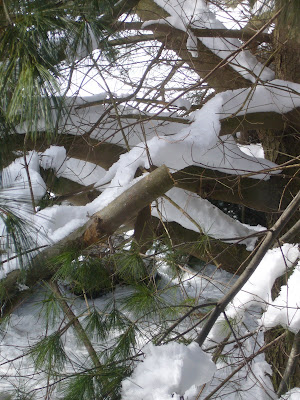The other problem in my yard was the view of the neighbor's trampoline. They kindly placed this right at the edge of their yard so that it is visible from my deck and almost every window on the back of my house. Fortunately, their kids never used it that much, but it is a huge eyesore.
So, I thought - why don't I pay someone to move the rock to the edge of the yard, put some more dirt on top of it, and create a berm that I could then plant and block the ugly view from the neighbor's yard. Great idea, but it has not worked out the way I planned.
First, I was expecting the rock on the bottom, the dirt on the top. Nope - the rock is mixed in with the dirt, making it a huge pain to plant things. Second, the dirt was full of weeds, and several years later, I am still dealing with this. Third, it doesn't really block the view of the trampoline - in some ways it accentuates it. We have created this focal point, that, at certain times of year, looks rather pretty, despite all of its problems. And unfortunately, the bushes on the berm are not tall enough (and not going to get tall enough) to block the trampoline. So instead of hiding it, I am now drawing attention to it!
(As a side note, the nieghbor's youngest child has just started college. Isn't it time to put the trampoline away? Please?)
The berm is 44 ft long. Most of it (and all of the problem area) is in full sun. About half the berm is planted with native grasses, bushes, trees, etc. It may not look perfect, but it works pretty well. The other half is planted with some pyracantha and black-eyed Susans. I picked the pyracantha because I wanted something evergreen and deer resistant. It is both, but it is too short and too sparse to hide anything. The black-eyed Susans look nice from a distance, but are being crowded by tons of weeds. Every year it gets a bit worse and is almost to the point where I should kill everything and start over.
Although the black-eyed Susans look great in the late summer, I think one of the problems with growing them by themselves is that they come up a bit late and the weeds get a headstart on them. To try to address this, I am going to plant several other perennials that bloom (and so hopefully come up) earlier, and presumably will help crowd out the weeds. The plants I have picked are all native, meadow type plants.
They are:
- Common milkweed (asclepias syriaca) -purple blooms May - August
- Butterfly weed (asclepias tuberosa) - orange blooms May - July
- Wild blue indigo (baptista australis) - blue blooms May - June
As for the pyracantha, my current plan is to leave it alone and plant additional bushes behind it (on the backside of the berm). The bushes have to be deer resistant, and I would prefer that they are native and evergreen. This narrows my options - a lot. The one criteria I am most willing to give on is evergreen.
I have narrowed my list to four possibilities:
- Silky Dogwood (cornus amomum) - grows 6-12 feet high, white flowers in spring, berries in August, good fall color (not evergreen)
- Inkberry (ilex glabra) - 6-10 feet high, evergreen, black berries, need both male and female plants
- Southern bayberry (morella cerifera) - 6-15 feet high, semi-evergreen, but probably not evergreen in my area
- Scrub oak (quercus ilicifolia) - 12-20 feet high, leaves persist into winter (holds dead leaves), good fall color
The last option is not a bush, but a small tree. All have good wildlife value. The bayberry is probably the least visually interesting, but probably the easiest to find. I like the idea of planting more oaks in my yard for their incredible wildlife value, but I am concerned that these trees will get too large for the area. If I had to guess now, I think I am going to end up with either the inkberry or the dogwood. Or maybe both? I need to figure out just how many of them I need.







